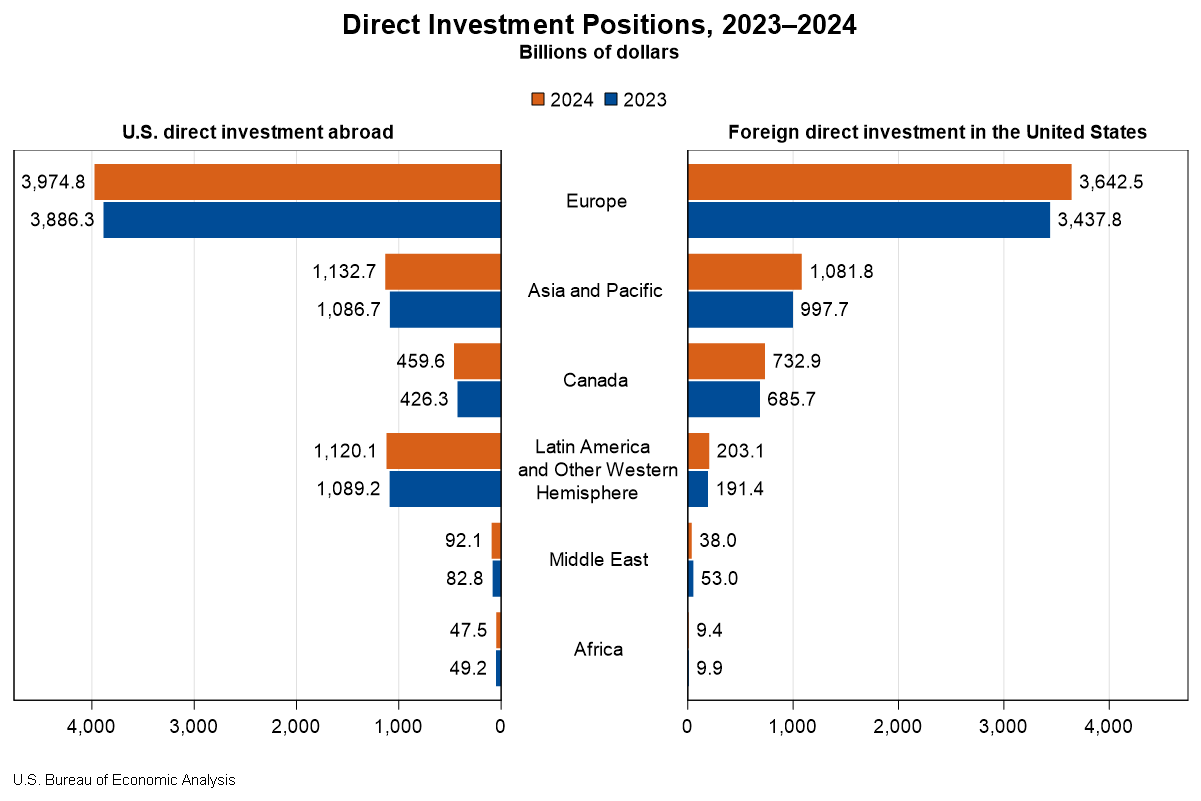Bureau of Economic Analysis
Direct Investment by Country and Industry, 2024
The U.S. direct investment abroad position, or cumulative level of investment, increased $206.3 billion to $6.83 trillion at the end of 2024, according to statistics released today by the U.S. Bureau of Economic Analysis. The increase was led by an $88.4 billion increase in the position in Europe, primarily in Luxembourg and Germany. By industry, manufacturing affiliates had the largest increase, led by manufacturing of computers and electronic products.
The foreign direct investment in the United States position increased $332.1 billion to $5.71 trillion at the end of 2024. The increase was led by a $204.7 billion increase in the position from Europe, which reflected a $52.9 billion increase from the United Kingdom and a $39.7 billion increase from Germany. By industry, affiliates in manufacturing increased the most.
Principal Federal Economic Indicators
Noteworthy
- 2025 News Release Schedule
- Innovation at BEA
- 2025 Annual Updates
- New! Services Trade Data for More Countries
- Data Tool: Trade in Value Added
- Distribution of State Personal Income
- Updated: RIMS II Regional Multipliers
- Arts and Culture
- Space Economy
- FDI Now in State BEARFACTS
- Quick Guide: Price Indexes
The Latest
Local Area Personal Income, 2009-2011
Personal income rose in 2011 in all of the nations 366 metropolitan statistical areas (MSAs) for the first time since 2007, according to estimates released today by the U.S. Bureau of Economic Analysis. Personal income growth ranged from 14.8 percent in Odessa, Texas to 1.0 percent in Rochester, Minnesota. Personal income in the United States rose 5.2 percent in 2011, up from 3.8 percent in 2010. Inflation, as measured by the national price…
Growth in Goods and Services Industries Slowed in 2011
Retail trade and durable goods manufacturing were the leading contributors to the deceleration in U.S. economic growth in 2011, according to revised statistics on the breakout of real gross domestic product (GDP) by industry from the Bureau of Economic Analysis.
Revised Statistics of Gross Domestic Product by Industry, 2009-2011
Retail trade and durable goods manufacturing were the leading contributors to the deceleration in U.S. economic growth in 2011, according to revised statistics on the breakout of real gross domestic product (GDP) by industry from the Bureau of Economic Analysis. Real GDP growth slowed in 2011, increasing 1.8 percent after increasing 2.4 percent in 2010. The revised statistics do not change the general picture of the economy: 12 of 22…
The Use Table: An Essential Tool That Looks Deep Inside the U.S. Economy
What’s the foundation for many economic statistics both inside and outside the Bureau of Economic Analysis (BEA)? It’s something most people have never heard of, yet it is essential for finding out what’s going on inside the world’s largest economy. It’s called the “use table,” and it is a fundamental tool of BEA’s input-output accounts. The use table provides both a broad and a detailed look at the U.S. economy. It is simple, yet…
September 2012 Trade Gap is $41.5 Billion
The U.S. monthly international trade deficit decreased in September 2012, according to the U.S. Bureau of Economic Analysis and the U.S. Census Bureau. The deficit decreased from $43.8 billion (revised) in August to $41.5 billion in September, as exports increased more than imports. The previously published August deficit was $44.2 billion. The goods deficit decreased $1.4 billion from August to $57.5 billion in September, and the services…
New Guide Helps Regional Developers, Planners Navigate RIMS II
People who conduct or examine local or regional economic impact studies will want to read a new handbook that offers some dos and don’ts on using the Bureau of Economic Analysis (BEA) Regional Input-Output Modeling System (RIMS II).
RIMS II, a regional economic model, is most frequently used by investors, regional planners, and government officials to gauge the economy-wide impact of a change in economic activity on a local community…
Real Consumer Spending Picks Up in September
Personal income increased 0.4 percent in September after increasing 0.1 percent in August. Wages and salaries, the largest component of personal income, increased 0.3 percent in September after increasing 0.1 percent in August. Government social benefits to persons turned up in September.
Current-dollar disposable personal income (DPI), after-tax income, increased 0.4 percent in September after increasing 0.1 percent in August.…
Personal Income and Outlays, September 2012
Personal income increased $48.1 billion, or 0.4 percent, and disposable personal income (DPI) increased $43.0 billion, or 0.4 percent, inSeptember, according to the Bureau of Economic Analysis. Personal consumption expenditures (PCE) increased $87.9 billion, or 0.8 percent. In August, personal income increased $17.8 billion, or 0.1 percent, DPI increased $15.1 billion, or 0.1 percent, and PCE increased $59.9 billion, or 0.5 percent, based on…
GDP Growth Picks up in Third Quarter
Real gross domestic product (GDP) increased 2.0 percent in the third quarter of 2012 after increasing 1.3 percent in the second quarter, according to estimates released today by the Bureau of Economic Analysis.
Third-quarter highlights The following contributed to the acceleration in real GDP growth:




